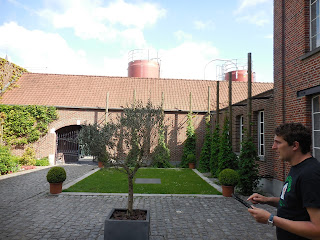 |
| Taking some pictures when we arrived |
The copper vessels were not quite what they appeared though, perhaps an early clue to the crypto-luciferianism I would soon see revealed.
Here's some more pictures of copper vessels.
And another one.
The fermenters weren't as pretty though:
The brewery was built in 1931, and the new brewhouse was put in in 2007. The grist for Orval is pale (50% proant free), cara and a small amount of black malt (one sack per 280hl!). It's wet milled at 62°C. They mash at 60°C for one hour, then 72°C for 20 minutes. Hop extact is added in the copper and some hop pellets are added to the lauter tun as an antioxidant. This last bit is a new one on me, so I wonder if it really works? After boiling the beer is centrifuges, liquored back and cooled to 17°C. Oxygen is added to 10ppm and yeast pitched at six million cells per ml.
Sucrose is added after cooling, raising the gravity from 1.042 to 1.054. The beer is down to 1.004 before bottling and drops to 1.000 after the Brettanomyces has done its work.
It takes six hours to do a brew and they brew five to six times a week. The water is treated with reverse osmosis and the CaCl2 and CaSO4 are added to 'mid level'. The wort has 50 IBU and the beer 32-35.
The beer spends five days in the fermenter, starting at 16°C, rising to 24°C. Fresh yeast is propagated for each brew, and it skips the lag and gets straight on with the exponential phase.
They have their own bottling line which seemed to be working fine. I've always suspected that using skittle shaped bottles must be a right pain in the arse but as far as I could see they had no more problems than usual.
The beer is dry hopped with bags of whole Strisselspalt hops in conditioning tanks, for between 10-20 days at 15°C.
Here's some of the conditioning tanks:
And here's a filter and a centrifuge:
After conditioning the beer is centrifuged, filtered, primed with sugar and re-seeded with yeast to 3 million cells per ml. Brettanomyces only makes up 1% of the yeast used for re-seeding. The beer is carbonated to 5g/l before bottling and will rise to 9.5g/l in the bottle. It is also at this stage that the anti-christ does his diabolic deeds: nitrogen is added to the beer to 15ppm to improve the head. It's also used for counter-pressure in the filler and liquid nitrogen is used for over foaming on capping.
Things got better in the lab:
Here are some Brettanomyces cultures:
At Orval they brew the same amount each week, all year round. They don't seem to have any plans to expand production so supplies are limited, even to the extent that sales from the brewery shop are rationed.
Mind you then can condition 17,000 cases at a time (at 17°C for min. 3 weeks) so that's still quite a bit of beer.
 |
| Thanks to the Head Brewer |
You can wander round the grounds of the monastery too, and of course exit via the gift shop.
 |
The monastery has been destroyed twice, once by fire in the middle ages and once during the French revolution.
We ate at the monastery's restaurant, which gave me a chance to try their patersbier, a weaker beer (4.5% ABV) made for the monks which they only sell here. As this was in all probablility a once in a lifetime opportunity to try it I was a bit concerned it would be rubbish. Happily that was not the case and I very much enjoyed it. The beer had a very fruity taste for those that are wondering.
And here's the main event:
 |
| Heavenly beer, dark satanic head that even a northerner would balk at |
 |
| Last picture before we went |
































